
by Helga Moser | Nov, 2025 | Bonn Sights, culinary, EN, points of interest, Rhine region, tradition
When the days get darker in the dreary month of November and the wet cold dampens the mood, I go to the Christmas market before the winter blues gets a hold of me. Around the Münsterplatz in Bonn, wooden stalls are set up and create a cosy atmosphere with Christmas decorations and bright lights. The enticing aromas of mulled wine, cinnamon, roasted almonds and delicious food inevitably lift the spirits.
At the foot of the Bonn Minster, the city is teeming with life, but at the same time it feels homely . I feel transported back in time and imagine how our Bonn ancestors came to this square in the late Middle Ages to stock up on supplies for the coming winter, to enjoy good food and drink and, of course, to exchange the latest gossip.
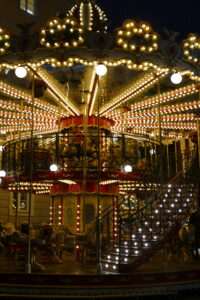
 Today, more than half a millennium later, it is not much different. In a large part of the 160 wooden stalls placed between Remigiusplatz, Münsterplatz and Friedensplatz, you can buy beautiful and useful items, including hand-made crafts, which make for great Christmas presents for family and friends. Here you will find unique items that are not available in the usual department stores. Inspired by the lovingly decorated displays, you’ll discover gifts that you would never have thought of while lounging on your sofa at home. For example, original jewellery pendants or maybe hand-knitted socks made of pure wool for your daughter, who always has cold feet? And for your girlfriend, who already has everything, a new Christmas ornament is always a hit! And of course, every once in a while I need a little refreshment. The Flammlachs (salmon cooked on an open fire) smells seductive, but I usually return to the Rhine-region classic, Reibekuchen, potatoe pancakes with apple compote. In addition, the sounds of Christmas can be heard from everywhere. The happy laughter of children coming from the direction of the historic carousel reminds me of the dear little ones in my family. For them, I have to make a choice between a handcrafted wooden toy and a cute Perlgraupentier (a figurine of a German miner). Slowly, the shopping bag I brought with me is proving not big enough. But I don’t need to worry because one of the traditional stalls has a selection of beautiful baskets: I have been eyeing them for a long time. No sooner said than done – now I just have to get the hand-made wrapping paper and my Christmas market tour will be a roaring success.
Today, more than half a millennium later, it is not much different. In a large part of the 160 wooden stalls placed between Remigiusplatz, Münsterplatz and Friedensplatz, you can buy beautiful and useful items, including hand-made crafts, which make for great Christmas presents for family and friends. Here you will find unique items that are not available in the usual department stores. Inspired by the lovingly decorated displays, you’ll discover gifts that you would never have thought of while lounging on your sofa at home. For example, original jewellery pendants or maybe hand-knitted socks made of pure wool for your daughter, who always has cold feet? And for your girlfriend, who already has everything, a new Christmas ornament is always a hit! And of course, every once in a while I need a little refreshment. The Flammlachs (salmon cooked on an open fire) smells seductive, but I usually return to the Rhine-region classic, Reibekuchen, potatoe pancakes with apple compote. In addition, the sounds of Christmas can be heard from everywhere. The happy laughter of children coming from the direction of the historic carousel reminds me of the dear little ones in my family. For them, I have to make a choice between a handcrafted wooden toy and a cute Perlgraupentier (a figurine of a German miner). Slowly, the shopping bag I brought with me is proving not big enough. But I don’t need to worry because one of the traditional stalls has a selection of beautiful baskets: I have been eyeing them for a long time. No sooner said than done – now I just have to get the hand-made wrapping paper and my Christmas market tour will be a roaring success.
A toast is in order! Relaxing as Christmas approaches, I treat myself to an eggnog, a drink made from white wine, egg liqueur, vanilla and sugar, served hot and garnished with whipped cream. It actually sounds rather fearsome, but it is surprisingly delicious and hits the spot. The fact that I’m standing here alone doesn’t bother me at all. Because we are in the Rhineland it takes no time at all before I am chatting with a fellow eggnog-drinker about the Christmas season.
Of course, this will not be my only visit to a Christmas market. Like so many, I will meet up with friends for a mulled wine on numerous occasions throughout the season. It sweetens up the dreary weather – and when it’s bitter cold outside, the drinks taste even better!
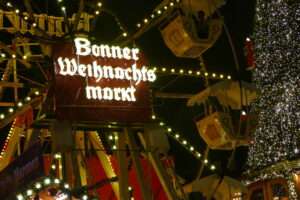 And soon, I’ll be going to the Bonn Greeters’ Christmas market meet-up, which takes place every year. We’ll be swapping anecdotes and information, taking a stroll through the rows of stalls and sampling the wares at various stands. Of course, it’s all preparation for when we show guests around the market, as Christmas markets are one of the top points of interest.
And soon, I’ll be going to the Bonn Greeters’ Christmas market meet-up, which takes place every year. We’ll be swapping anecdotes and information, taking a stroll through the rows of stalls and sampling the wares at various stands. Of course, it’s all preparation for when we show guests around the market, as Christmas markets are one of the top points of interest.
The Christmas market is open until 23 December, with stalls open from 11 a.m. to 9 p.m., and food and drink stalls open until 9:30 p.m. on Sundays to Thursdays, and until 10:30 p.m. on Fridays and Saturdays. And for those who don’t want to leave the cosy setting so quickly, Bonn Tourism there is a Holy Three Kings’ market, which will extend beyond the pre-Christmas period. It will take place on Remigiusplatz from 27 December up to and including 6 January.
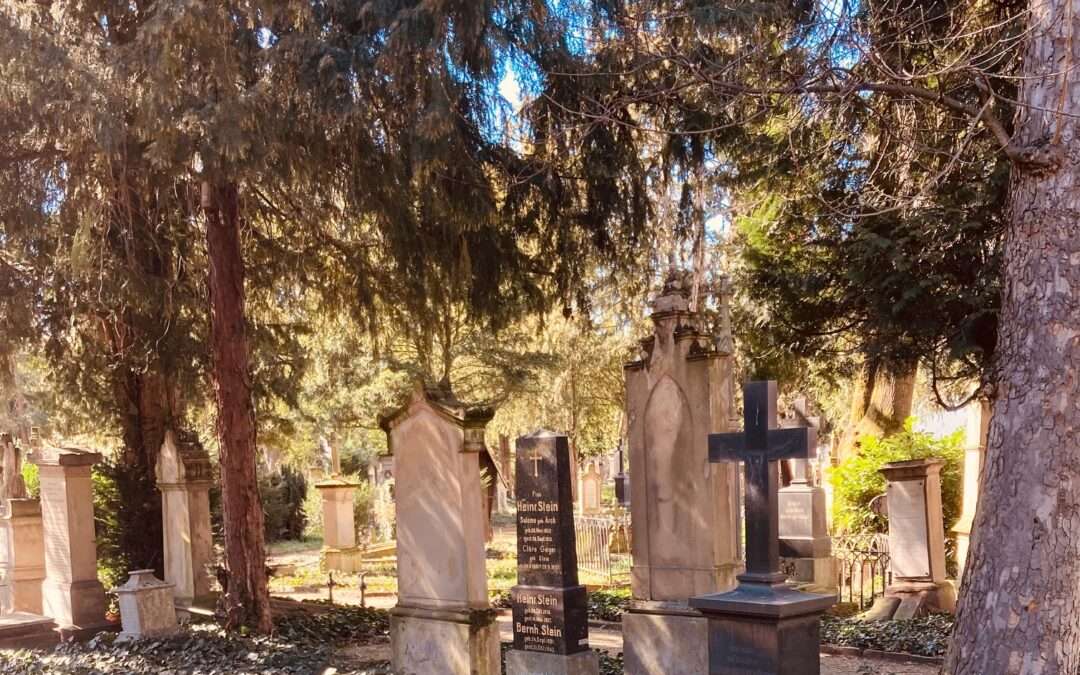
by Gert Fischer | Oct, 2025 | Bonn Sights, famous people from Bonn, history, points of interest
In 2025, the Fördergesellschaft für den Alten Friedhof Bonn e.V. (Friends of Bonn’s Old Cemetery Association) celebrates its 50th anniversary. The Bonn Greeters would like to offer their heartfelt congratulations! Through its work, the association makes an important contribution to the preservation and maintenance of one of Bonn’s most significant historical landmarks.
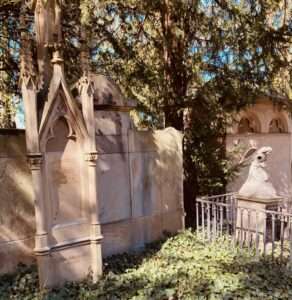 The so-called ‘Old Cemetery’ is easy to overlook. It is surrounded by walls and squeezed between three main roads and the railway line. Its entrance is at the beginning of Bornheimer Straße, almost directly next to the town hall. When you walk through the gate you enter another world. Graves from times long past lie in the shade of tall trees. Weathered gravestones and rusted wrought-iron crosses dominate the scene. Some are crooked. Many of the graves are obviously no longer maintained and are overgrown. The traffic noise fades into the background and birdsong dominates. It is no wonder that feature films are occasionally shot here. Fog machines are turned on and eerie figures stride through the night. The rattling of the railway is suppressed.
The so-called ‘Old Cemetery’ is easy to overlook. It is surrounded by walls and squeezed between three main roads and the railway line. Its entrance is at the beginning of Bornheimer Straße, almost directly next to the town hall. When you walk through the gate you enter another world. Graves from times long past lie in the shade of tall trees. Weathered gravestones and rusted wrought-iron crosses dominate the scene. Some are crooked. Many of the graves are obviously no longer maintained and are overgrown. The traffic noise fades into the background and birdsong dominates. It is no wonder that feature films are occasionally shot here. Fog machines are turned on and eerie figures stride through the night. The rattling of the railway is suppressed.
The cemetery has been in existence since 1715. At that time, it was located just outside the city fortifications. It owes its triangular layout to the fork in the road where Archbishop Elector Joseph Clemens – better known as the creator of the residential palace, now the university – had it laid out. It was originally intended for soldiers, strangers and poor people, i.e. those whose families did not have graves in the inner-city cemeteries. In 1787, it became the city’s only cemetery: Elector Max Franz closed the parish cemeteries and turned it into a ‘general burial ground’. The reason for this was the realisation that the overcrowded churchyards posed a health risk to the city’s population. In this respect, Bonn was ahead of its time. In most other cities in the Rhineland, such measures were only ordered during French rule after 1794.
The Old Cemetery retained its function as ‘the’ Bonn cemetery until its closure in 1884. From then on, burials were only permitted if the family already had a grave on the site, as there was no more room for expansion. The cemetery was surrounded by buildings on all sides.
An information board at the entrance, as well as the Fördergesellschaft’s website, offer maps and a detailed overview of the VIP tombstones . There is much more to discover than the graves of Beethoven’s mother, Clara and Robert Schumann, Barthold Georg Niebuhr or Ernst Moritz Arndt, because the Old Cemetery reflects the history of bourgeois Bonn in the 19th century. In addition to the graves of well-known and lesser-known Bonn families, the resting places of university professors also play an important role. This part of the cemetery register reads like a “Who’s Who” of the German scholarly world of that time. Scattered across the grounds, we also find traces of the British colony, which was important for the social history of the city. Somewhat hidden away are the graves of French soldiers from the war of 1870/71. Added to this is the art-historical dimension. A tour of the cemetery is always a journey through the representative funeral culture of the 19th century. Particularly important are the cemetery chapel – built in the 13th century as the chapel of the Teutonic Order in Ramersdorf and moved here in the 1840s as an early example of monument preservation – and the former market cross of the medieval market in Dietkirchen in the north of Bonn.
 Another treasure of the Old Cemetery is its trees, some of which date back to the 19th century. This is where problems become apparent: in some places, monument preservation and nature conservation compete with each other, as the tree roots threaten historic graves. Nowhere is this more evident than at the grave of Ernst Moritz Arndt, where the oak tree he planted himself almost 200 years ago is in the process of overturning the gravestones.
Another treasure of the Old Cemetery is its trees, some of which date back to the 19th century. This is where problems become apparent: in some places, monument preservation and nature conservation compete with each other, as the tree roots threaten historic graves. Nowhere is this more evident than at the grave of Ernst Moritz Arndt, where the oak tree he planted himself almost 200 years ago is in the process of overturning the gravestones.
Another problem is that the majority of the graves are no longer in use. The families have died out or now bury their members elsewhere. This means that time has practically stood still. This is a major challenge for the city, because although it can preserve the site as a whole, it does not have the resources to maintain the countless unused graves, let alone preserve the gravestones, apart from the graves of honour. On the other hand, ‘clearing’ the graves after the burial periods have expired, as is customary in normal cemeteries, is not an option due to the historical significance of the site and the existing monument protection. The support association helps to solve this dilemma. Among other things, it is responsible for the restoration of graves of historical or art-historical significance.
Another option is the ‘grave sponsorships’ arranged by the support association. In this case, the sponsors take over the maintenance of an abandoned grave, including the restoration of the gravestone, and thus acquire the right from the city of Bonn to be buried in this grave sometime in the future. Not everyone may like the idea of lying under someone else’s gravestone and being limited to a modest stone cushion with their own name on it. And some people also consider it morbid for someone to maintain their own grave during their lifetime. However, my wife and I find it somehow reassuring to know where we will end up – if nothing else comes in between.
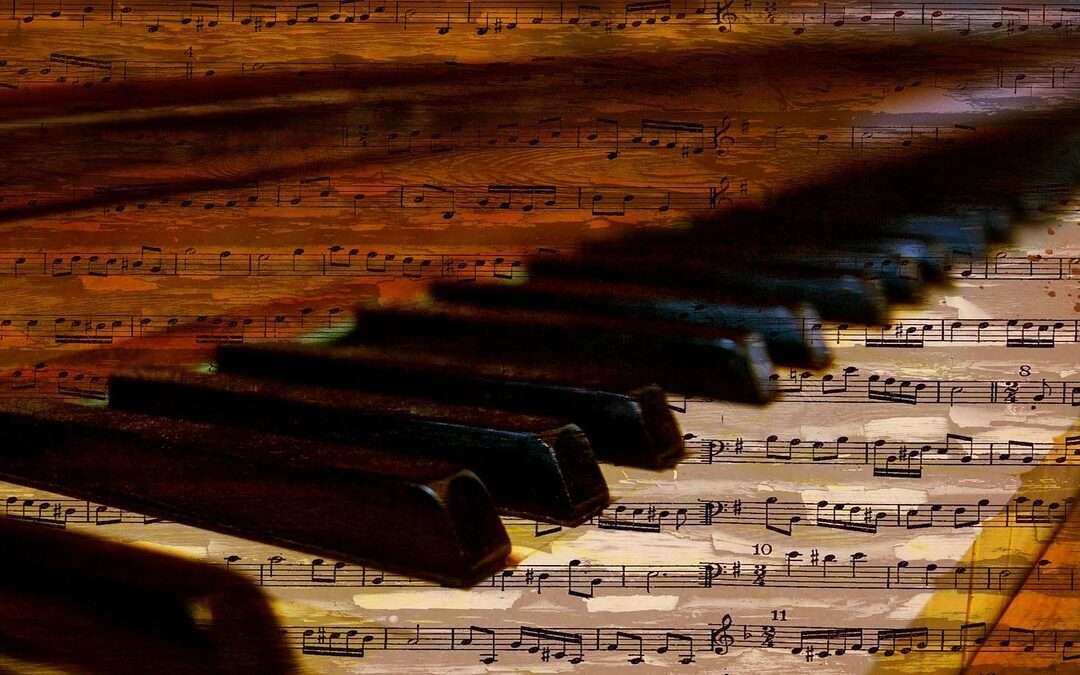
by Ursula Dillenburger-Brendt | Oct, 2025 | EN, Events, Music
Telekom Beethoven Competition: 04. – 13. December, 2025
In December, Bonn will once again become the international centre of the piano world. In Beethoven’s birthplace, the renowned Telekom Beethoven Competition is challenging outstanding classical pianists from all over the world aged between 18 and 32 to compete for the top three places for the 11th time since 2005.
An international selection committee headed by Pavel Gililov, artistic director and jury president of the competition, hand-picked the 28 participants in spring 2025. They have been preparing for the competition ever since, as the repertoire is extremely demanding, the requirements and expectations are extremely high, and the competition is fierce. Half of the exceptional talents come from Asia, seven of them from South Korea alone, while Europe is represented by eight candidates, including Jonas Stark from Germany.
 The competition begins in the concert hall of the Telekomzentrale (Friedrich-Ebert-Allee 140, 53113 Bonn) and is open to the public. Every music lover has the fantastic opportunity to attend the competition. Admission is free, only permitted between each audition. And if you have to wait a little while to get in, that’s no problem, as the competition is livestreamed around the world, including to the Telekom lounge, where you can sit down with a cup of coffee and listen.
The competition begins in the concert hall of the Telekomzentrale (Friedrich-Ebert-Allee 140, 53113 Bonn) and is open to the public. Every music lover has the fantastic opportunity to attend the competition. Admission is free, only permitted between each audition. And if you have to wait a little while to get in, that’s no problem, as the competition is livestreamed around the world, including to the Telekom lounge, where you can sit down with a cup of coffee and listen.
In the first round, from Friday 5th to Sunday 7th December, all 28 participants will perform. (Time: 10 a.m. – approx. 9 p.m.) The programme includes a prelude and fugue by Johann Sebastian Bach and one of the last three sonatas, as well as another work by Ludwig van Beethoven. Wonderful piano works, sure to be played beautifully! It’s well worth going along to listen and compare. Don’t forget to keep your fingers crossed! The high-calibre jury will select the twelve most outstanding talents from among the competitors.
In the second round, on Monday, 8th and Tuesday, 9th December, the remaining 12 pianists will be back. (Time: 10 a.m. – approx. 9 p.m.) The competition requires the interpretation of a sonata or variations by Ludwig van Beethoven and a Romantic piano work. The audience, some of whom are very enthusiastic and regularly attend the competition, are now fired up, lively discussions taking place during the breaks about who is the most convincing, and everyone hoping that their favourite will progress. But the jury will decide which six of the participants will be admitted to the semi-finals. The audience will find out the result the next morning.
The semi-final for the six selected contestants will take place on Wednesday, 10 December. (Time: 10 a.m. – 7 p.m.) The programme includes another sonata by Beethoven and a modern work from the 20th century. It’s getting more and more exciting! Only the three pianists who excel in this preliminary round will advance to the next rounds of the competition. They will then have the opportunity to showcase their skills in a different context in two further concerts.
In the chamber music final on Friday, 12 December, the three finalists will perform together with members of the Beethoven Trio Bonn. (7 p.m.) Here they will demonstrate their sensitivity in musical interaction as well as their sense of balance and sound culture. But it begins with a solo performance of a contemporary work from the 21st century, followed by a piano trio by Ludwig van Beethoven performed together with Mikhail Ovrutsky (violin) and Grigory Alumyan (cello). With such contrasting pieces of music, the concert promises to be interesting. Incidentally, the works performed here are the only ones in the entire competition that do not have to be performed from memory. (Tickets are required to attend the chamber music final)
The absolute highlight of the Telekom Beethoven Competition is undoubtedly the orchestra final with the three finalists on Saturday, 13 December. (new venue: Telekom Forum, Landgrabenweg 151, 53227 Bonn, 7 p.m.) Here, the three contenders for the prize will take to the stage together with the Beethoven Orchestra Bonn and each perform a piano concerto by Ludwig van Beethoven under the musical direction of Oksana Lyniv. The exact programme is unknown until then, as the jury will decide which works the finalists will play based on their artistic profile and repertoire.
Before the three pianists begin, they will each introduce themselves in a video. This will allow the audience to learn about their training and mentors, some personal details, as well as their preferences and aspirations. And then the great piano concertos will begin! For anyone who loves Beethoven’s piano concertos and can’t get enough of them, this orchestra finale is a must! You can’t get more Beethoven piano concerto than this! (Admission tickets are also required here)
 When the last note has faded away, there is a long, long pause. The audience waits eagerly in the foyer. Then, finally, the jury announces the rankings of the three finalists. The award ceremony, sponsored by Telekom, forms the festive conclusion to the concert evening: the 1st prize (€50,000), the 2nd prize (€25,000) and the 3rd prize (€10,000) are officially announced and presented to the winners.
When the last note has faded away, there is a long, long pause. The audience waits eagerly in the foyer. Then, finally, the jury announces the rankings of the three finalists. The award ceremony, sponsored by Telekom, forms the festive conclusion to the concert evening: the 1st prize (€50,000), the 2nd prize (€25,000) and the 3rd prize (€10,000) are officially announced and presented to the winners.
However, for the young pianists, the concert engagements, long-term support and associated network of concert halls and event organisers that come with the top prizes are certainly more important than the prize money. For example, the first two winners will give their debut concerts at the Beethovenfest in 2026 and 2027, respectively, and the winner will go on a concert tour of Germany with the Klassische Philharmonie Bonn in 2026, visiting over 10 cities. Further concerts in Europe are planned. How wonderful! This gives the audience, who have been so excited about the young artists, the opportunity to hear them again and follow their development.

by Annette Bohlen | Sep, 2025 | architecture, EN, history, points of interest
Built in 1957 and kidney-shaped, with a tiled base and a wide canopy: a (cult) kiosk in the middle of the UN and former government district in Bonn.
In this district, somewhat away from the city centre, there has never been many shops or restaurants, just a small row of kiosks for essentials during government times. But the most important newspapers were available at Jürgen Rasche’s kiosk, named after his mother, the long-time owner. This is where prominent politicians of the time, such as Joschka Fischer and Norbert Blüm, as well as employees of the surrounding federal institutions and journalists would meet for a coffee or a bratwurst. In this government district, the distances to offices and meetings or to the plenary hall were short on foot or by bicycle, and people liked to meet for personal exchanges in the absence of other options in the press club, in Villa Dahm or in the small bar under the substitute plenary hall on the banks of the Rhine. Or – as mentioned – for a quick exchange of information at the Büdchen.
-
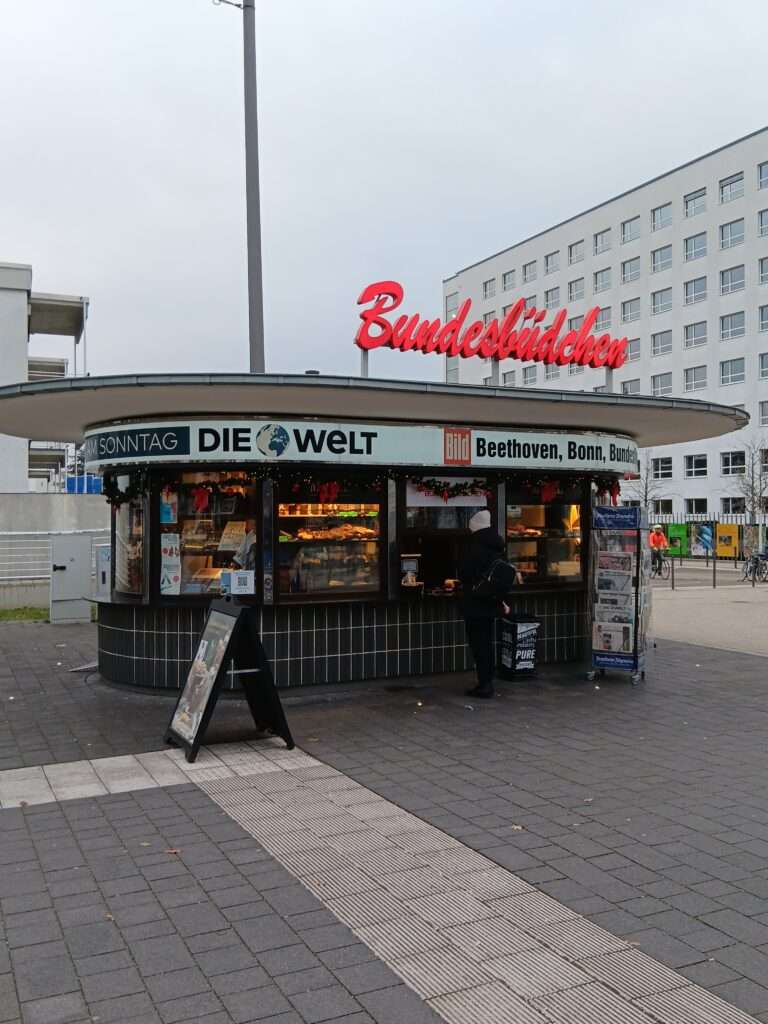
With the relocation of the capital to Berlin in 1999, the Bundesbüdchen initially lost its importance and eventually had to make way for the new WCCB (World Conference Centre Bonn) building. At least the noble kiosk was saved by its listed status and stored in a freight yard. It remained a symbol for the people of Bonn of the city’s heyday as the seat of government, so a dedicated support association was eventually able to finance its restoration, and today we can enjoy this relic from the days of government, now located next to the World Conference Centre, where bread rolls, cakes and more are sold.

by Gert Fischer | Aug, 2025 | EN, famous people from Bonn, history, Music, tradition
Nowadays, Beethoven festivals are almost routine. They take place annually. There is stable funding (we will draw a veil over the years 1993 to 1998), early planning by the artistic director and a firm foothold in the city’s society. At the first Beethoven Festival in 1845, everything was very different.

 The occasion for the celebrations was not only the 75th birthday of the master, who died in 1827, but above all the inauguration of the Beethoven monument by the Dresden sculptor Ernst Hähnel on Münsterplatz. It all stemmed from what we would today call a ‘civic initiative’. At its helm was August Wilhelm Schlegel, one of the greats of the German scholarly world. His successor was a less fortunate choice. Heinrich Carl Breidenstein, the university’s ‘music director’, was a proven expert but had a difficult character. He was always controversial in Bonn society and was also openly attacked due to his enthusiasm for modern music (apart from Beethoven, he admired Liszt and Berlioz). He was simply not up to the task of organising a music festival with hundreds of guests in a small town without infrastructure or experience (Bonn had less than 20,000 inhabitants at the time). The matter was further complicated by the fact that King Frederick William IV and his guest Queen Victoria intended to attend. The support of Franz Liszt, which had already been needed to finance the monument, was a double-edged sword. Liszt’s connections were helpful, but his exuberant self-confidence was not. He polarised opinions and virtually invited criticism.
The occasion for the celebrations was not only the 75th birthday of the master, who died in 1827, but above all the inauguration of the Beethoven monument by the Dresden sculptor Ernst Hähnel on Münsterplatz. It all stemmed from what we would today call a ‘civic initiative’. At its helm was August Wilhelm Schlegel, one of the greats of the German scholarly world. His successor was a less fortunate choice. Heinrich Carl Breidenstein, the university’s ‘music director’, was a proven expert but had a difficult character. He was always controversial in Bonn society and was also openly attacked due to his enthusiasm for modern music (apart from Beethoven, he admired Liszt and Berlioz). He was simply not up to the task of organising a music festival with hundreds of guests in a small town without infrastructure or experience (Bonn had less than 20,000 inhabitants at the time). The matter was further complicated by the fact that King Frederick William IV and his guest Queen Victoria intended to attend. The support of Franz Liszt, which had already been needed to finance the monument, was a double-edged sword. Liszt’s connections were helpful, but his exuberant self-confidence was not. He polarised opinions and virtually invited criticism.
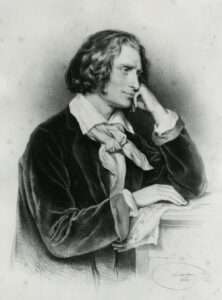 When Liszt arrived in Bonn a few weeks before the festival, at which he was to conduct alongside court conductor of Kurhessen Spohr, he immediately made his mark. He flatly rejected Breidenstein’s idea of using the Hussars’ riding arena in front of the northern city wall as a concert hall – according to a contemporary source, a ‘stinking hut’. The result was perhaps the greatest miracle in Bonn’s architectural history, which is otherwise not particularly rich in miracles: in less than two weeks, a consortium of Bonn carpenters, with the support of Cologne cathedral master builder Zwirner, erected a wooden festival hall in the ‘Raess’schen Gärten’. Today, we know this area as the car park in the Viktoriakarrée. With a height of around 7 metres, the building measured approximately 62 × 23 metres. However, it is difficult for us today to understand how contemporaries calculated that this space of just over 1,400 square metres could accommodate up to 3,000 visitors plus an orchestra and choir. The Bayernzelt at Pützchens Markt needs more than 2,000 square metres for such large numbers. In any case, the concerts are said to have been attended by around 2,000 people each. Incidentally, the hall was sold for demolition a few weeks after the end of the festival. The wish of the correspondent of the Leipziger Zeitung thus remained unfulfilled. At the end of September, he had wished the hall a long life as a music venue and not as a carnival’s hall. This is somewhat reminiscent of the current discussions about the use of today’s Beethoven Hall.
When Liszt arrived in Bonn a few weeks before the festival, at which he was to conduct alongside court conductor of Kurhessen Spohr, he immediately made his mark. He flatly rejected Breidenstein’s idea of using the Hussars’ riding arena in front of the northern city wall as a concert hall – according to a contemporary source, a ‘stinking hut’. The result was perhaps the greatest miracle in Bonn’s architectural history, which is otherwise not particularly rich in miracles: in less than two weeks, a consortium of Bonn carpenters, with the support of Cologne cathedral master builder Zwirner, erected a wooden festival hall in the ‘Raess’schen Gärten’. Today, we know this area as the car park in the Viktoriakarrée. With a height of around 7 metres, the building measured approximately 62 × 23 metres. However, it is difficult for us today to understand how contemporaries calculated that this space of just over 1,400 square metres could accommodate up to 3,000 visitors plus an orchestra and choir. The Bayernzelt at Pützchens Markt needs more than 2,000 square metres for such large numbers. In any case, the concerts are said to have been attended by around 2,000 people each. Incidentally, the hall was sold for demolition a few weeks after the end of the festival. The wish of the correspondent of the Leipziger Zeitung thus remained unfulfilled. At the end of September, he had wished the hall a long life as a music venue and not as a carnival’s hall. This is somewhat reminiscent of the current discussions about the use of today’s Beethoven Hall.
It was thanks in no small part to Liszt that hundreds of guests from out of town had gathered in Bonn on the eve of the celebrations. In addition to Beethoven enthusiasts including many Englishmen and a large group of Frenchmen led by Hector Berlioz, Liszt’s personal fan club also attended (mainly ladies who were almost hysterically devoted to him). Among them was the ‘it girl’ of her generation, Lola Montez, who was a dancer and always good for a scandal. How close she was to the maestro during those days was obvious.
The festival got off to a good start. The opening concert on the evening of August 10th, conducted by Louis Spohr, featured the Ninth and the Missa Solemnis. Even the critical critics were satisfied – although Spohr admitted that he had not known the Missa at all and had had to learn it in a crash course shortly before the concert. The next day was a day of rest, so to speak. The programme was limited to christening a ‘steamboat’ named Ludwig van Beethoven and taking it on a day trip to Nonnenwerth. On this and many other occasions, the people of Bonn held out their hands. The out-of-town guests found this unusual, and even local Gottfried Kinkel complained about the rampant commercialism and excessive merchandising.
The main reason for the festival, the unveiling of the monument on 12 August, was no longer under a lucky star. After a high mass in the cathedral, during which Berlioz had to climb over a barrier to reach his seat, the crowd gathered tightly packed on the cathedral square. It took an hour and a half before Their Highnesses, coming from Brühl, appeared on the balcony of the Fürstenberg Palace, today’s post office. The festive song composed by Breidenstein and ‘shouted by a male choir’ was blown away by the wind, as was his speech, which was delivered too quietly. The unveiling itself, however, was not the ‘scandal’ that many later generations would have us believe. Queen Victoria merely noted in her diary that it was unfortunate that the statue could only be seen from the back. It was not she, but King Frederick William IV who expressed his surprise, audible only to his immediate neighbours. Alexander von Humboldt, standing next to him, made the matter the most famous anecdote in Bonn’s city history with his reply: ‘Your Majesty, please bear in mind that Beethoven was also a rough fellow during his lifetime.’
The final day was the 13th and indeed an unlucky day. The grand morning ‘artists’ concert’ began an hour late, even though the king had asked for it to start without him and his guests. The egomaniac Liszt nevertheless delayed the start because he did not want to conduct his own cantata without royal accompaniment. This was untenable, but as luck would have it, the distinguished guests arrived just as the piece ended. So the maestro started from the beginning. The rest of the audience was not amused. After a few more items on the programme, the princes had to leave for Cologne to visit the cathedral. The audience was once again by themselves and had two more hours of music to endure. When it was time for lunch, most of the audience left the hall (‘Too much torment!’). The concert lasted until half past one.
The low point in the evening was reached at the banquet in the ‘Hotel zum goldenen Stern’ on the market square. Despite many toasts, Liszt did not acknowledge the French delegation. This led to turmoil and the ladies present fled. Only Lola Montez remained and danced on the table. Liszt had to lock her in her hotel room, where she promptly smashed the furniture.
Today’s Beethoven festivals are more civilised. The only reminder of 1845 is the iconic monument on Münsterplatz. And perhaps that’s just as well.

by Ursula Dillenburger-Brendt | Jun, 2025 | EN, Events, Music, tradition
On August 28th, the time has come: The Beethovenfest 2025 will open under the patronage of Hendrik Wüst, Minister-President of NRW, followed by over 100 events in and around Bonn until September 27th. During this time, the city of Bonn will be dedicated to its greatest son, Ludwig van Beethoven, and his music. The festival looks back on a long and rich history. It first took place in 1845 on the occasion of the ceremonial inauguration of the Beethoven monument on Bonn’s Münsterplatz. Composer Franz Liszt played a key role in its realisation, both as a financier and as artistic director of the entire celebration. He promptly devised a multi-day festival and, as conductor, designed the musical events in a concert hall specially built in 11 days. It was the beginning of a festival tradition that continues to this day. Initially held only on important Beethoven anniversaries, pianist Elly Ney established a regular schedule for the festival in the 1930s. Since the construction of the new Beethoven Hall in 1959, it has taken place every two to three years, and since 1999, every autumn for four weeks. The people of Bonn support the festival with two associations, the “Freundeskreis Beethovenfest Bonn e.V.” and the “Bürger für Beethoven“, and with their regular attendance.
The festival has always seen itself as a bridge between tradition and innovation, treating Beethoven’s works not as a museum opus, but as a source of inspiration for musical exploration. Beethoven’s pieces are performed, reinterpreted and juxtaposed with contemporary music. Furthermore, commissions encourage a modern, direct engagement.
This year’s festival motto “Alles ultra”, loosely adapted from J.W. von Goethe, is fitting. The slogan stands for the pursuit of new things, creative innovation, and the pushing of boundaries. While Goethe denounced the excesses of his contemporaries as a problematic development resulting in disorientation and mediocrity with “Everything but… is now ultra! Everything transcends unstoppably, in thought as well as in action” in 1825, in Bonn 2025, “Everything ultra” is reinterpreted and understood not only as an interpretation of world events but above all as an expression of Beethoven’s nature and his musical genius. For it was precisely the nonconformist Beethoven who often took uncharted paths and actively and innovatively approached the future. Appropriately, artistic director Steven Walter is promising “around 100 events to celebrate our colourful, vibrant, and, despite all the social concerns, also full of opportunities. A festival is dedicated to human diversity, the positively crazy, and the humanistic “ultras” – entirely in the spirit of Beethoven” and promises: “The Beethovenfest Bonn 2025 will be loud, it will be surprising, it will be chic, it will be moving – and certainly ultra!” – Well then!
 If you look through the Beethovenfest program, you will indeed discover a lively potpourri of concert forms. As expected, there are the major symphony concerts at the Opera House by famous orchestras playing works by Beethoven (2nd, 3rd, 5th, 6th, 7th, 8th Symphonies as well as the Violin Concerto – after all, it is still the Beethovenfest), but also symphonic works by Mozart, Shostakovich, Stravinsky, and others. Also notable are the many chamber concerts taking place at a wide variety of venues: Classical chamber music, with piano and string ensembles, is primarily represented in the Chamber Music Hall of the Beethovenhaus. At the other venues performances are mixed according to the motto “Anything but classical” where unusual, new and even improvised interplay between various instruments creates unusual yet fascinating sound experiences. For example, the Kreuzkirche offers cross-genre soundscapes, a walk-in musical theatre and relaxed after-work concerts. The “Pantheon,” “Harmonie,” and “Haus der Springmaus” cabaret theatres offer a colourful mix of performances, and percussion concerts are popular at the Dransdorf tram station.
If you look through the Beethovenfest program, you will indeed discover a lively potpourri of concert forms. As expected, there are the major symphony concerts at the Opera House by famous orchestras playing works by Beethoven (2nd, 3rd, 5th, 6th, 7th, 8th Symphonies as well as the Violin Concerto – after all, it is still the Beethovenfest), but also symphonic works by Mozart, Shostakovich, Stravinsky, and others. Also notable are the many chamber concerts taking place at a wide variety of venues: Classical chamber music, with piano and string ensembles, is primarily represented in the Chamber Music Hall of the Beethovenhaus. At the other venues performances are mixed according to the motto “Anything but classical” where unusual, new and even improvised interplay between various instruments creates unusual yet fascinating sound experiences. For example, the Kreuzkirche offers cross-genre soundscapes, a walk-in musical theatre and relaxed after-work concerts. The “Pantheon,” “Harmonie,” and “Haus der Springmaus” cabaret theatres offer a colourful mix of performances, and percussion concerts are popular at the Dransdorf tram station.
The Beethovenfest Bonn has always been distinguished by its international appeal and high artistic quality. The program serves as a platform for encounters and artistic exchange between renowned musicians and up-and-coming young talents. As part of the Fellowship Program and the Beethoven Talents program, young musicians are given the opportunity to make the leap to the stage with exclusive master classes, coaching, and concerts. Bonn pianist Fabian Müller, now a star of the Bonn music scene, has already taken this path. He will be represented at the Beethovenfest with five concerts. He will conduct his own orchestra with Beethoven’s Symphonies Nos. 2 and 3 and, over four evenings, he will complete his project to play all 32 Beethoven sonatas, spread across two festivals. He will precede each Beethoven work with his own musical preface. Listening to him is a pleasure, and attending one of his concerts is highly recommended.
“Alles Ultra” from August 28 to September 27, 2025, in Bonn? The Beethovenfest, with its blend of traditional and innovative, will offer us a sizzling mix where everyone is sure to find something for themselves and can even be tempted to try something new. I’m looking forward to it!


 Today, more than half a millennium later, it is not much different. In a large part of the 160 wooden stalls placed between Remigiusplatz, Münsterplatz and Friedensplatz, you can buy beautiful and useful items, including hand-made crafts, which make for great Christmas presents for family and friends. Here you will find unique items that are not available in the usual department stores. Inspired by the lovingly decorated displays, you’ll discover gifts that you would never have thought of while lounging on your sofa at home. For example, original jewellery pendants or maybe hand-knitted socks made of pure wool for your daughter, who always has cold feet? And for your girlfriend, who already has everything, a new Christmas ornament is always a hit! And of course, every once in a while I need a little refreshment. The Flammlachs (salmon cooked on an open fire) smells seductive, but I usually return to the Rhine-region classic, Reibekuchen, potatoe pancakes with apple compote. In addition, the sounds of Christmas can be heard from everywhere. The happy laughter of children coming from the direction of the historic carousel reminds me of the dear little ones in my family. For them, I have to make a choice between a handcrafted wooden toy and a cute Perlgraupentier (a figurine of a German miner). Slowly, the shopping bag I brought with me is proving not big enough. But I don’t need to worry because one of the traditional stalls has a selection of beautiful baskets: I have been eyeing them for a long time. No sooner said than done – now I just have to get the hand-made wrapping paper and my Christmas market tour will be a roaring success.
Today, more than half a millennium later, it is not much different. In a large part of the 160 wooden stalls placed between Remigiusplatz, Münsterplatz and Friedensplatz, you can buy beautiful and useful items, including hand-made crafts, which make for great Christmas presents for family and friends. Here you will find unique items that are not available in the usual department stores. Inspired by the lovingly decorated displays, you’ll discover gifts that you would never have thought of while lounging on your sofa at home. For example, original jewellery pendants or maybe hand-knitted socks made of pure wool for your daughter, who always has cold feet? And for your girlfriend, who already has everything, a new Christmas ornament is always a hit! And of course, every once in a while I need a little refreshment. The Flammlachs (salmon cooked on an open fire) smells seductive, but I usually return to the Rhine-region classic, Reibekuchen, potatoe pancakes with apple compote. In addition, the sounds of Christmas can be heard from everywhere. The happy laughter of children coming from the direction of the historic carousel reminds me of the dear little ones in my family. For them, I have to make a choice between a handcrafted wooden toy and a cute Perlgraupentier (a figurine of a German miner). Slowly, the shopping bag I brought with me is proving not big enough. But I don’t need to worry because one of the traditional stalls has a selection of beautiful baskets: I have been eyeing them for a long time. No sooner said than done – now I just have to get the hand-made wrapping paper and my Christmas market tour will be a roaring success. And soon, I’ll be going to the Bonn Greeters’ Christmas market meet-up, which takes place every year. We’ll be swapping anecdotes and information, taking a stroll through the rows of stalls and sampling the wares at various stands. Of course, it’s all preparation for when we show guests around the market, as Christmas markets are one of the top points of interest.
And soon, I’ll be going to the Bonn Greeters’ Christmas market meet-up, which takes place every year. We’ll be swapping anecdotes and information, taking a stroll through the rows of stalls and sampling the wares at various stands. Of course, it’s all preparation for when we show guests around the market, as Christmas markets are one of the top points of interest.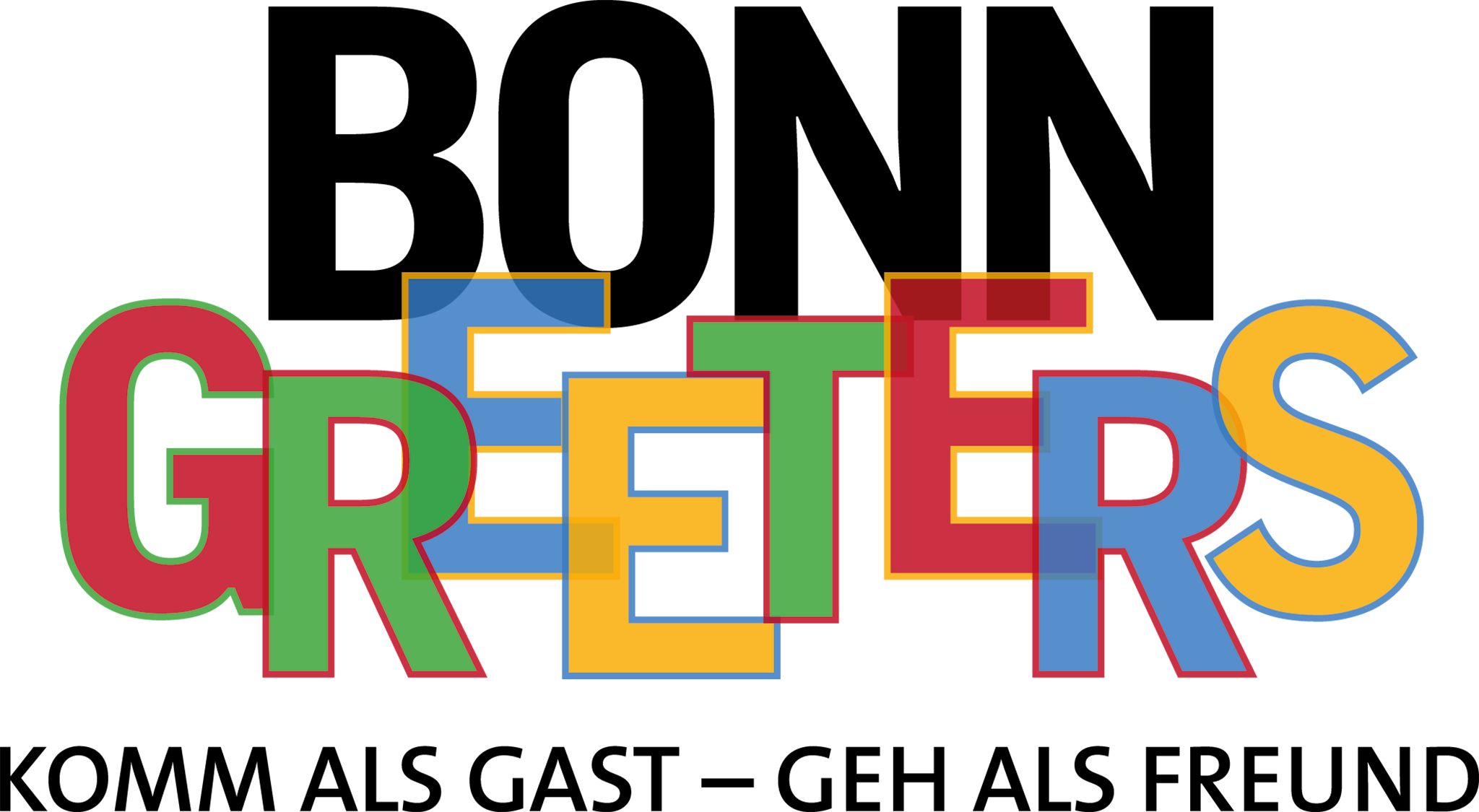

 The so-called ‘Old Cemetery’ is easy to overlook. It is surrounded by walls and squeezed between three main roads and the railway line. Its entrance is at the beginning of Bornheimer Straße, almost directly next to the town hall. When you walk through the gate you enter another world. Graves from times long past lie in the shade of tall trees. Weathered gravestones and rusted wrought-iron crosses dominate the scene. Some are crooked. Many of the graves are obviously no longer maintained and are overgrown. The traffic noise fades into the background and birdsong dominates. It is no wonder that feature films are occasionally shot here. Fog machines are turned on and eerie figures stride through the night. The rattling of the railway is suppressed.
The so-called ‘Old Cemetery’ is easy to overlook. It is surrounded by walls and squeezed between three main roads and the railway line. Its entrance is at the beginning of Bornheimer Straße, almost directly next to the town hall. When you walk through the gate you enter another world. Graves from times long past lie in the shade of tall trees. Weathered gravestones and rusted wrought-iron crosses dominate the scene. Some are crooked. Many of the graves are obviously no longer maintained and are overgrown. The traffic noise fades into the background and birdsong dominates. It is no wonder that feature films are occasionally shot here. Fog machines are turned on and eerie figures stride through the night. The rattling of the railway is suppressed.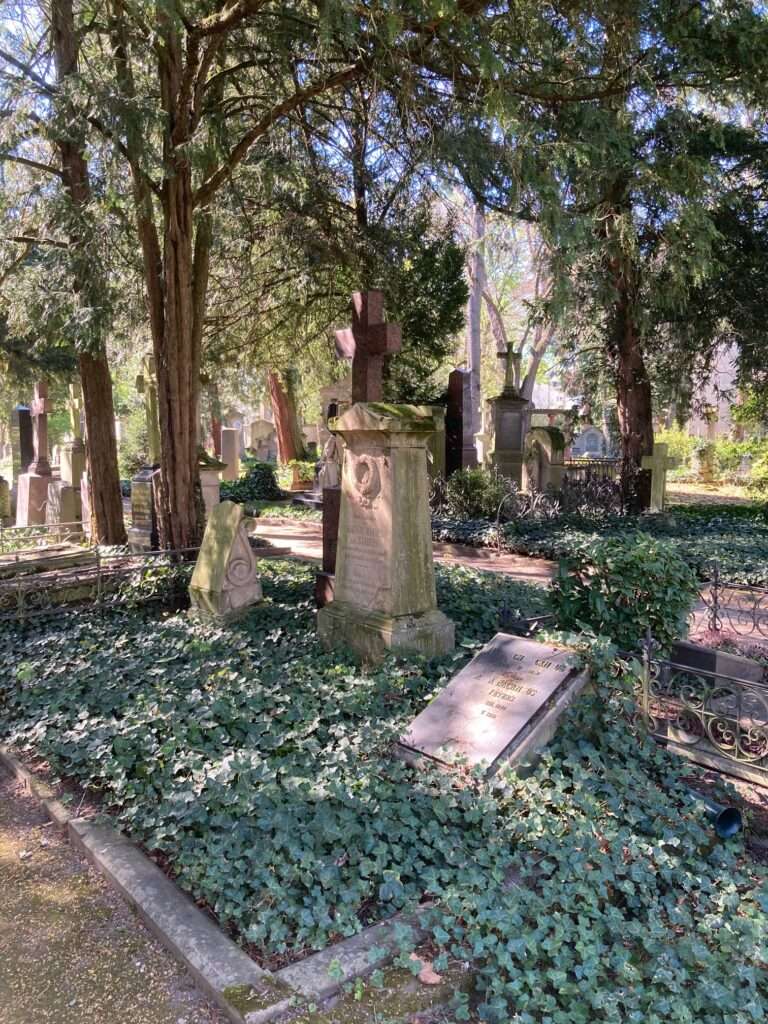
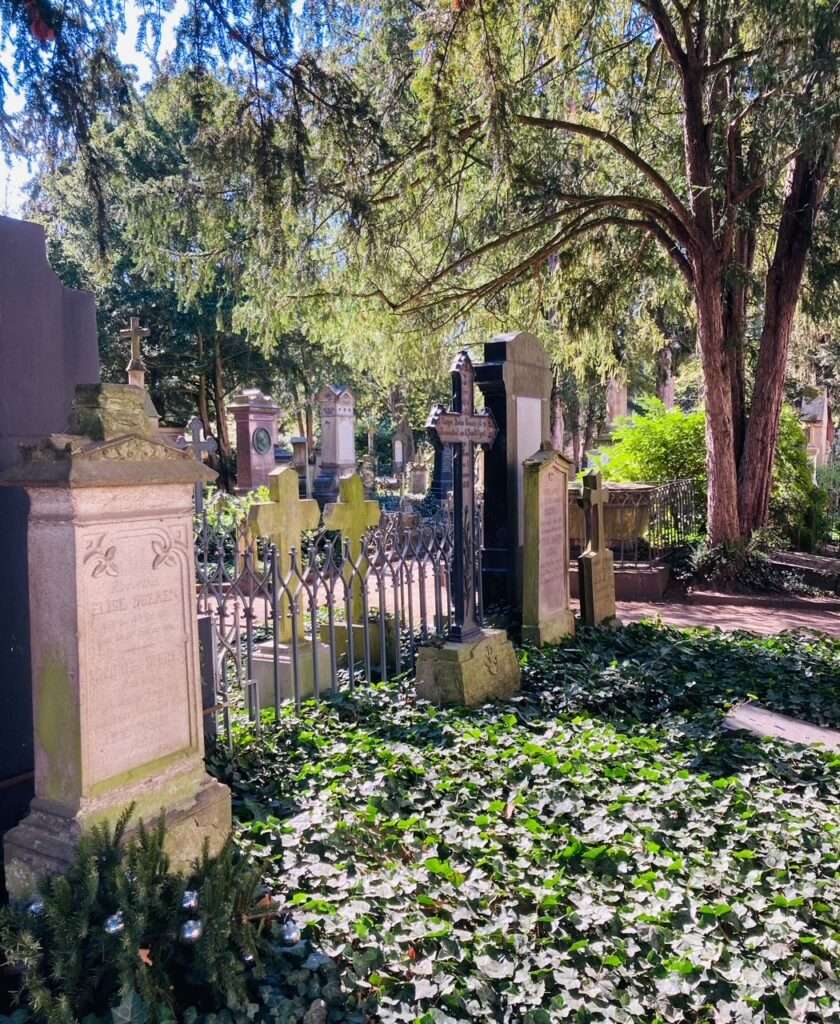
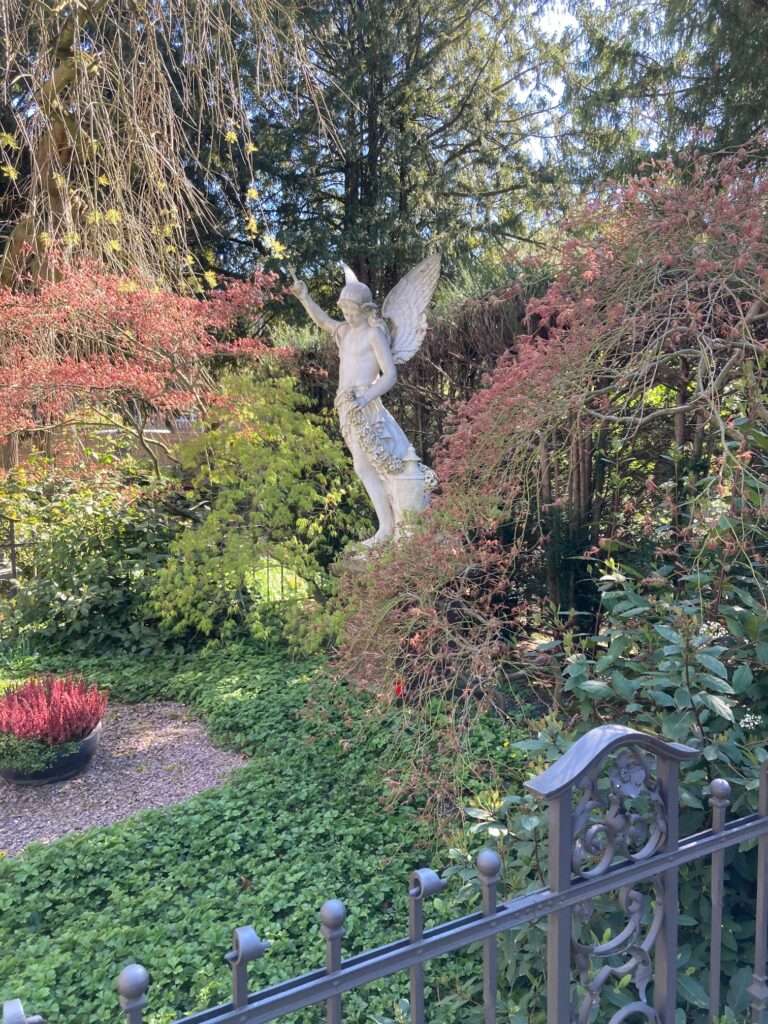
 Another treasure of the Old Cemetery is its trees, some of which date back to the 19th century. This is where problems become apparent: in some places, monument preservation and nature conservation compete with each other, as the tree roots threaten historic graves. Nowhere is this more evident than at the grave of Ernst Moritz Arndt, where the oak tree he planted himself almost 200 years ago is in the process of overturning the gravestones.
Another treasure of the Old Cemetery is its trees, some of which date back to the 19th century. This is where problems become apparent: in some places, monument preservation and nature conservation compete with each other, as the tree roots threaten historic graves. Nowhere is this more evident than at the grave of Ernst Moritz Arndt, where the oak tree he planted himself almost 200 years ago is in the process of overturning the gravestones.
 The competition begins in the concert hall of the Telekomzentrale (Friedrich-Ebert-Allee 140, 53113 Bonn) and is open to the public. Every music lover has the fantastic opportunity to attend the competition. Admission is free, only permitted between each audition. And if you have to wait a little while to get in, that’s no problem, as the competition is livestreamed around the world, including to the Telekom lounge, where you can sit down with a cup of coffee and listen.
The competition begins in the concert hall of the Telekomzentrale (Friedrich-Ebert-Allee 140, 53113 Bonn) and is open to the public. Every music lover has the fantastic opportunity to attend the competition. Admission is free, only permitted between each audition. And if you have to wait a little while to get in, that’s no problem, as the competition is livestreamed around the world, including to the Telekom lounge, where you can sit down with a cup of coffee and listen. When the last note has faded away, there is a long, long pause. The audience waits eagerly in the foyer. Then, finally, the jury announces the rankings of the three finalists. The award ceremony, sponsored by Telekom, forms the festive conclusion to the concert evening: the 1st prize (€50,000), the 2nd prize (€25,000) and the 3rd prize (€10,000) are officially announced and presented to the winners.
When the last note has faded away, there is a long, long pause. The audience waits eagerly in the foyer. Then, finally, the jury announces the rankings of the three finalists. The award ceremony, sponsored by Telekom, forms the festive conclusion to the concert evening: the 1st prize (€50,000), the 2nd prize (€25,000) and the 3rd prize (€10,000) are officially announced and presented to the winners.



 The occasion for the celebrations was not only the 75th birthday of the master, who died in 1827, but above all the inauguration of the Beethoven monument by the Dresden sculptor
The occasion for the celebrations was not only the 75th birthday of the master, who died in 1827, but above all the inauguration of the Beethoven monument by the Dresden sculptor  When Liszt arrived in Bonn a few weeks before the festival, at which he was to conduct alongside court conductor of Kurhessen Spohr, he immediately made his mark. He flatly rejected Breidenstein’s idea of using the Hussars’ riding arena in front of the northern city wall as a concert hall – according to a contemporary source, a ‘stinking hut’. The result was perhaps the greatest miracle in Bonn’s architectural history, which is otherwise not particularly rich in miracles: in less than two weeks, a consortium of Bonn carpenters, with the support of Cologne cathedral master builder Zwirner, erected a wooden festival hall in the ‘Raess’schen Gärten’. Today, we know this area as the car park in the Viktoriakarrée. With a height of around 7 metres, the building measured approximately 62 × 23 metres. However, it is difficult for us today to understand how contemporaries calculated that this space of just over 1,400 square metres could accommodate up to 3,000 visitors plus an orchestra and choir. The Bayernzelt at Pützchens Markt needs more than 2,000 square metres for such large numbers. In any case, the concerts are said to have been attended by around 2,000 people each. Incidentally, the hall was sold for demolition a few weeks after the end of the festival. The wish of the correspondent of the Leipziger Zeitung thus remained unfulfilled. At the end of September, he had wished the hall a long life as a music venue and not as a carnival’s hall. This is somewhat reminiscent of the current discussions about the use of today’s
When Liszt arrived in Bonn a few weeks before the festival, at which he was to conduct alongside court conductor of Kurhessen Spohr, he immediately made his mark. He flatly rejected Breidenstein’s idea of using the Hussars’ riding arena in front of the northern city wall as a concert hall – according to a contemporary source, a ‘stinking hut’. The result was perhaps the greatest miracle in Bonn’s architectural history, which is otherwise not particularly rich in miracles: in less than two weeks, a consortium of Bonn carpenters, with the support of Cologne cathedral master builder Zwirner, erected a wooden festival hall in the ‘Raess’schen Gärten’. Today, we know this area as the car park in the Viktoriakarrée. With a height of around 7 metres, the building measured approximately 62 × 23 metres. However, it is difficult for us today to understand how contemporaries calculated that this space of just over 1,400 square metres could accommodate up to 3,000 visitors plus an orchestra and choir. The Bayernzelt at Pützchens Markt needs more than 2,000 square metres for such large numbers. In any case, the concerts are said to have been attended by around 2,000 people each. Incidentally, the hall was sold for demolition a few weeks after the end of the festival. The wish of the correspondent of the Leipziger Zeitung thus remained unfulfilled. At the end of September, he had wished the hall a long life as a music venue and not as a carnival’s hall. This is somewhat reminiscent of the current discussions about the use of today’s 
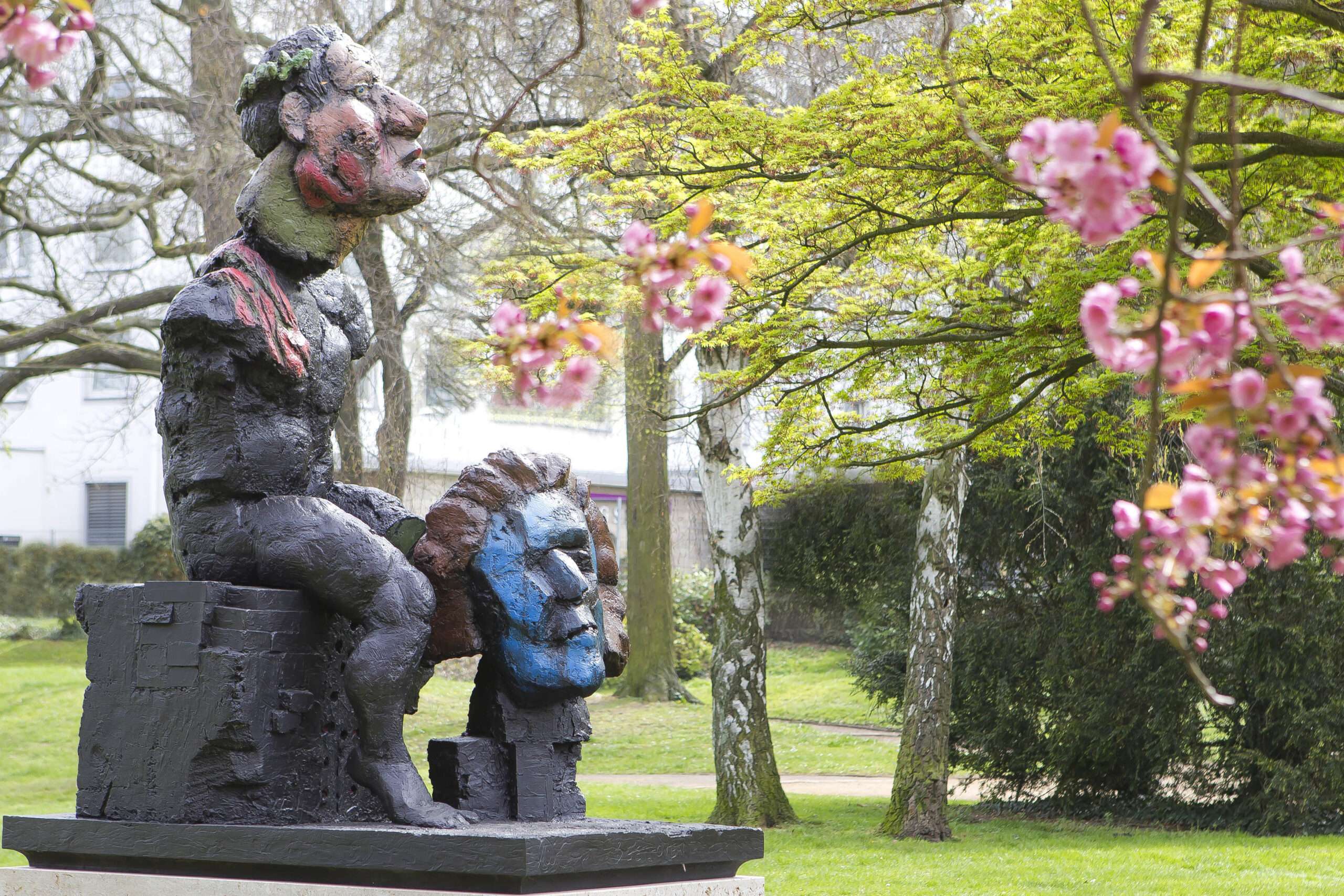
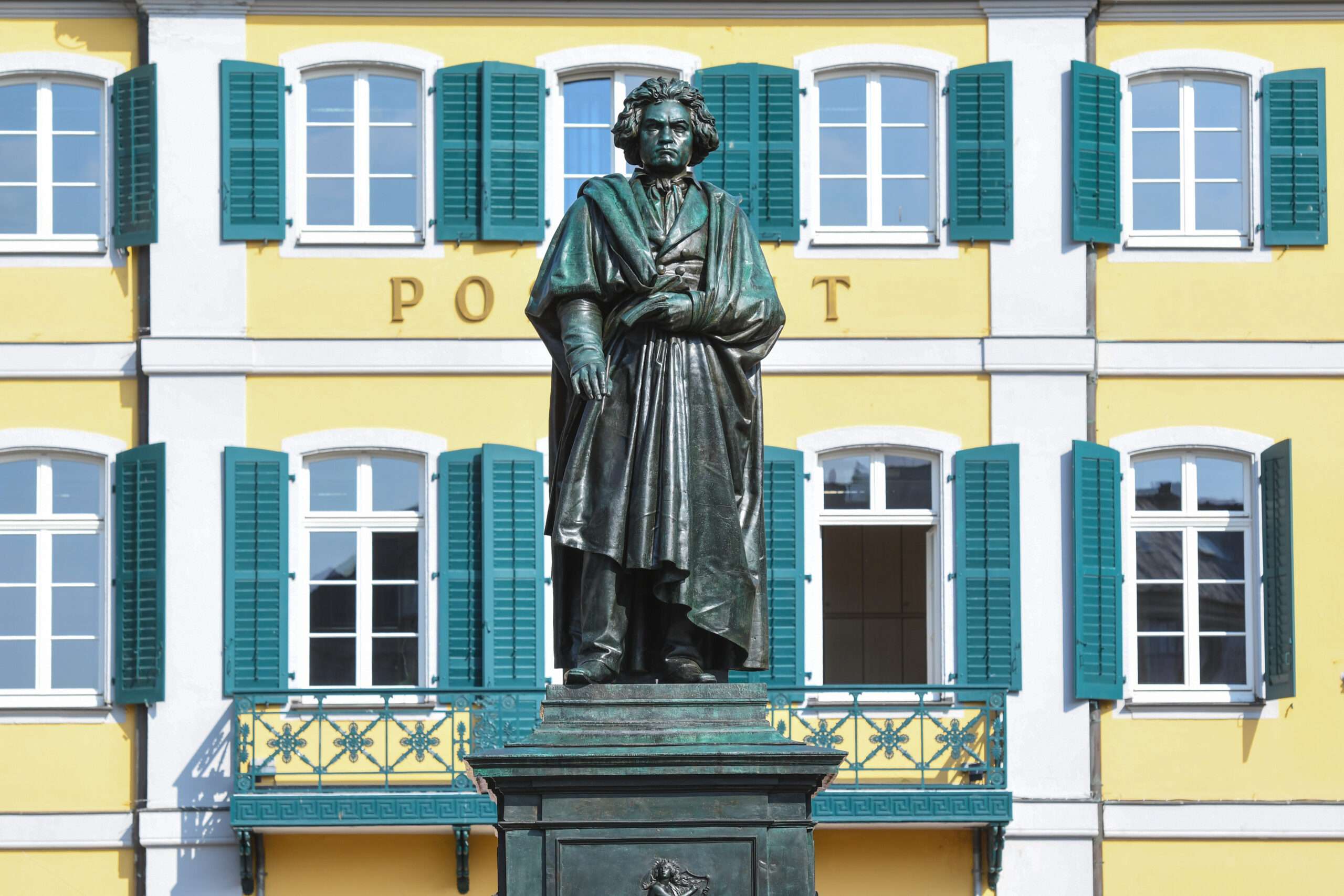
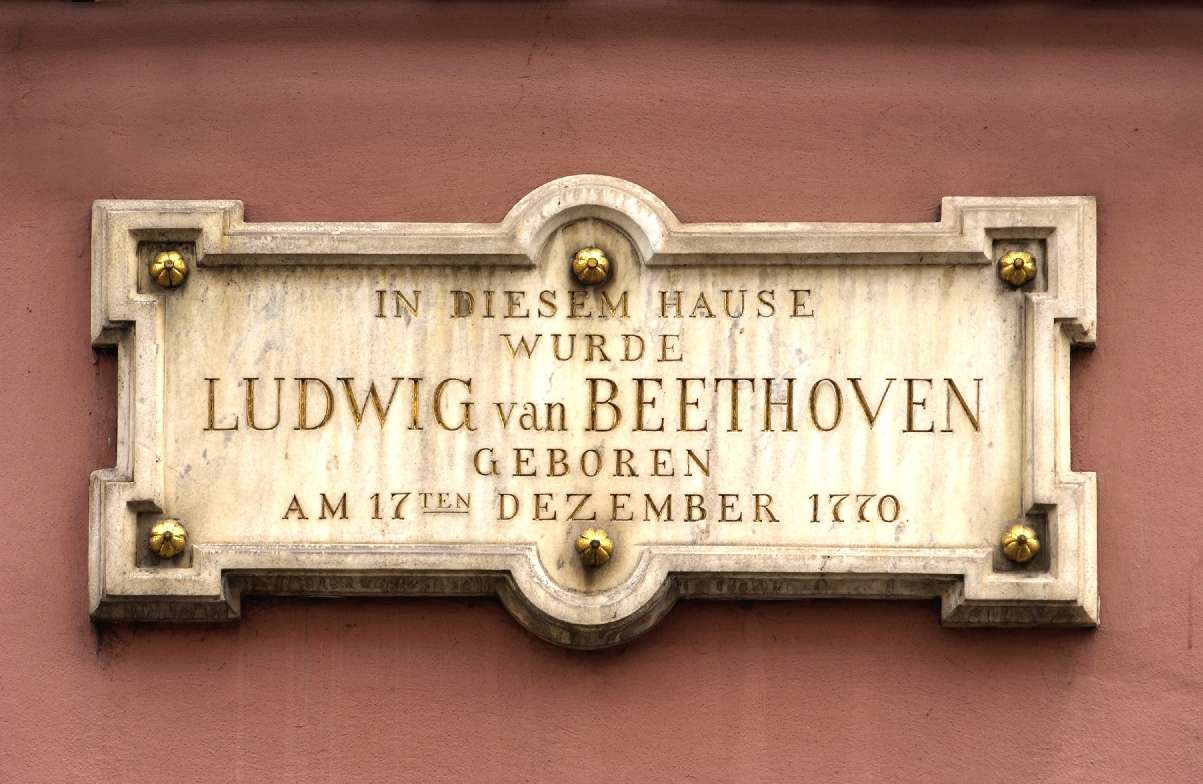
 If you look through the
If you look through the
Recent Comments